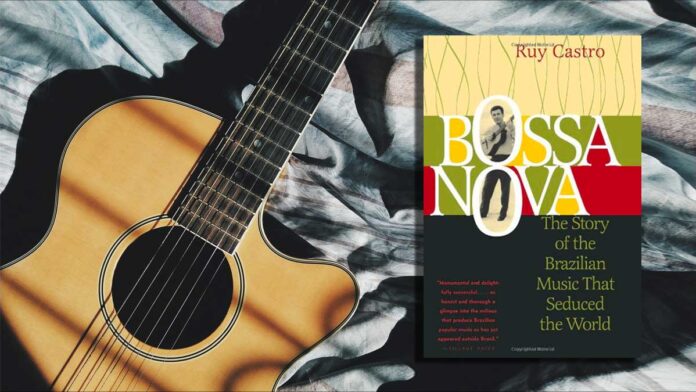
Ruy Castro’s Bossa Nova is an immersive real-life story of the music and personalities who created it.
Ruy Castro’s Bossa Nova is more than an important book. For die-hard fans, nothing could be better than this page-turner.
by Scott Adams
Ruy Castro just so happens to be one of the greatest living personifications of Bossa Nova – a fact that even the music’s legendary stalwarts, such as Roberto Menescal, Marcos Valle, and Sergio Mendes would take only passing issue with, if at all.
As an author and a fan, his exuberance and personal enthusiasm are evident on the pages of the many books he’s written to define Bossa Nova’s legacy.
That might seem to be an odd statement, given that Rio’s identity is so attached to the Bossa beat but the fact is that precious little of its history has been chronicled as we head into its 6th decade as one of the world’s truly unique pop music styles. Perhaps only rock music has achieved greater influence internationally.
Only a few of his books have made it to English translation, but happily, Ruy Castro’s Bossa Nova is one of them.
Ruy Castro’s Bossa Nova Is An American History
Bossa Nova’s history here in the USA is pretty clear: As the story goes, guitarist Charlie Byrd was the first to bring João Gilberto’s albums back from Brazil after a State Department diplomatic tour of Latin America in 1961. He played them for saxophonist Stan Getz and they convinced producer Creed Taylor to record Jazz Samba in February 1962.
But uncovering Bossa Nova’s story in Brazil was… challenging.
While researching the project 30 years ago, Ruy Castro went to painstaking ends to uncover the real story – by talking with hundreds of the people who lived through those heady days in the Brazilian winter of 1958.
The stories he collected were revealing – to the point of protest by some of the characters involved – when the book was first published in 1990. To say that Castro was dedicated to writing a factual accounting is an understatement, and to date, no serious challenge to his clarity has been published.
Bossa Nova Is An Immersice Experience
But what makes this book a pleasure to spend time with is the author’s wit and insight, coupled with a clever sense of humor. And even in English, his personal and abiding relationship with Bossa Nova is crystal clear: Here is a man who found much more than he bargained for, and created a crusade with his efforts.
And I’m part of it, too. I joined up in 1994 when a soft cover copy of the original edition in Portuguese found its way into my hands. Then the English edition of Ruy Castro’s Bossa Nova came out, and my personal copy is page-worn in the way that favorite books happily become.
- Sign up for our weekly e-letter from Connectbrazil.com
As a result, walking through Ipanema these days brings a sense of nostalgic satisfaction. And always, my imagination swirls: It’s not that I’m stepping on shadows, more like strolling among legends.
I can skip the ‘Garota de Ipanema’ bar (been there, done that) in favor of Bar Astor for a midday chopp. But I never pass up an opportunity to stop by Toca de Vinicius, a little shop that stands as a bastion for Bossa Nova in the face of Ipanema’s high-rise modernity.
Among the books and music, I’ll seek out the owner to share a warm abração and to enquire about Ruy Castro.
“You just missed him,” is the usual smiling reply. “He was here only yesterday!”
Order Your Copy of Ruy Castro’s Bossa Nova
You can support Connect Brazil when you order Ruy Castro’s Bossa Nova by sending us an email request, with our thanks.
Music, Travel, Friends, And Fun!
Ruy Castro’s Bossa Nova
Stories like ‘Ruy Castro’s Bossa Nova’ are what we do. Why not join us? Join our list. Listen to our live streaming station and 15 streaming channels, all free. Browse our Lifestyle Directory and events coast to coast. And follow us on Twitter and Facebook.








